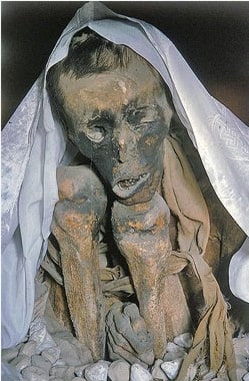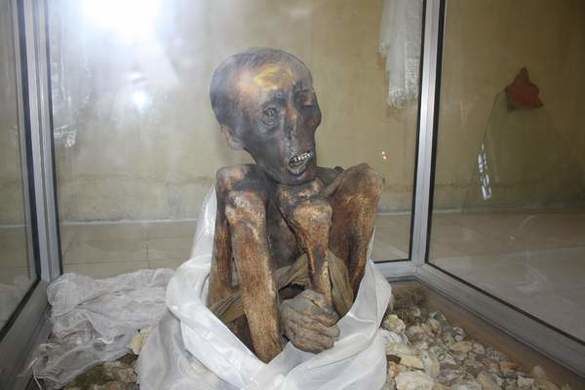‘Mysteries and Mummies’ create an exceptional pair. The word ‘mummy’ though immediately induces our hippocampus to meditate upon the time-enduring ancient pharaohs of Egypt that witnessed the preservation of corpse with specialized oils and minerals, the concept of natural self-mummification in India still remains unknown to many.
Owing to India’s vast size, extra ordinary cultural differences, astounding religious dominations and mythological stories, it naturally becomes a land of strange tales and bizarre mysteries.With most of them still unsolved and having no proper scientific reasoning, these mysteries scribble arcs of doubt and strongly urges one to delve into its depths in order to excavate the real findings. However, these uncanny incidents seem to have a never-ending disclosure that drives many scientists and historians insane.
To the surprise of many, India too witnesses the existence of a natural mummy. India is indeed on an expedition to unveil the mystery behind the mummy that has its origin at Gue, a desolated hamlet in the Spiti Valley. This mysterious figure is no doubt a vital reason that draws several tourists to the snow-laden province of Himachal Pradesh. Almost 550 years old, this mummy belongs to SanghaTenzin, a Buddhist monk who started this astonishing self-mummification process, not after his death, but rather while he was still living.This spine-chilling incident is ought to give its viewers sleepless nights after witnessing how a dead man looks like while he is seated upright!

It was the earthquake of 1975 that striked the wind-sculpted valley and uncovered an old stupa in Gue. The mummified body of Tenzin peeped from inside the tomb that had been preserving it. However, it was only in 2004 that the exposed tomb was finally excavated and the mummy was successfully recovered. As a tribute to this Buddhist monk, the local reverentials erected a small square concrete museum amidst the handful of mud houses at Gue and the mummy was finally given a shelter inside it merely bounded by thin glass sheets against the four walls. The body, even today, lie inside it with its skin intact, teeth visible through open lips and even the hair on the head persists. His body is kept in a seated posture with a restrainer called the gomtag around the neck and the thighs that has been holding him in place since his times of meditation.
The story of SanghaTenzin speaks about self-sacrifice. He was known to have given his life for the survival of the villagers, the reason why such a deep veneration was accorded to his body by the local folklore. It so happened that before his death he asked his followers to let him mummify himself after a devastating scorpion infestation took an unexpected occurrence in the village. The moment his spirit abandoned his body, it is strongly believed that a rainbow appeared on the horizon following which the scorpions disappeared bringing a complete end to the terrible plague. Quite a miraculous mystery indeed!
Traditionally termed as the Sokushinbutsu, this enigmatic practice of natural self-mummification was known to be carried out only by the Nyingma section of Buddhist monks. It is an unbelievably difficult process in which the body is coerced to react in such a way that its fats and fluids eventually mitigate. The process begins while the monk is still alive. Depriving oneself from cereals and legumes that bring in fat to the body for a prolonged extension, and thereby gradually facilitating organ degeneration is the primary objective of this procedure. This is continued until the body grows strong enough to resist degradation. It is during this period of slow starvation that the monks run candles along the skin to help it gradually dry out. Alongside, a special diet consisting of herbs, roots and tree-sap is also consumed in order to deplete the moisture from the body and preserve the meat on the bone. The high levels of residual nitrogen that resulted out of prolonged starvation in Tenzin’s body make it obvious that he strictly followed this procedure to mummify himself.
Soon after Sangha Tenzin’s death, his body was carefully substituted in an underground room with the purpose of an intense drying. This carried on for nearly three years until it was treated with candles for a second time. As time moved on, his physical body literally transformed into a mere concrete statue in meditation a ‘living Buddha’ as these mummies are notably known as.
Despite the use of no such artificial preservatives and exposure to elements, the mummy, even at present, shows not much of deterioration. As such, visitors to Gue’s unique museum can clearly observe Tenzin’s well-preserved form — right from the intact hairs on its head and empty eye sockets to the darkened, taut skin on its broad forehead. As it sits firmly with its fist around one leg and chin resting on its knee, the mummified monk seems to be engrossed in contemplation as he gazes out at the surreal landscape beyond.
Till date, only a handful of these self-mummified monks have been reported around the world, most of them excavated from Tibet and East Asia where monks were believed to intensely follow this austere practice of natural mummification. The preservation of the mummies in these areas found ease probably due to the aridity of the landscape and the cold climatic persistence. However, a concrete detailing of the reasons behind what made them undergo such a unique process still remains a curious matter of discussion.
A lot of controversies persist surrounding the self-mummication process of SanghaTenzin. However, this remarkable mystery upholding such ascetic practice has indeed left the world awe-struck. Dwelling with abundant solace amidst the high ranges of the Western Himalayas, the mummy at Gue attracts several sightseers, scientists and explorers. The mummy of Sangha Tenzin stands here as a consecrated element that speaks loud about the gift of sacrifice, a sacrifice that was indeed incredible. It was divine! It was eternal! And so is his mysterious body!
By Angela Perris, Kolkata
















